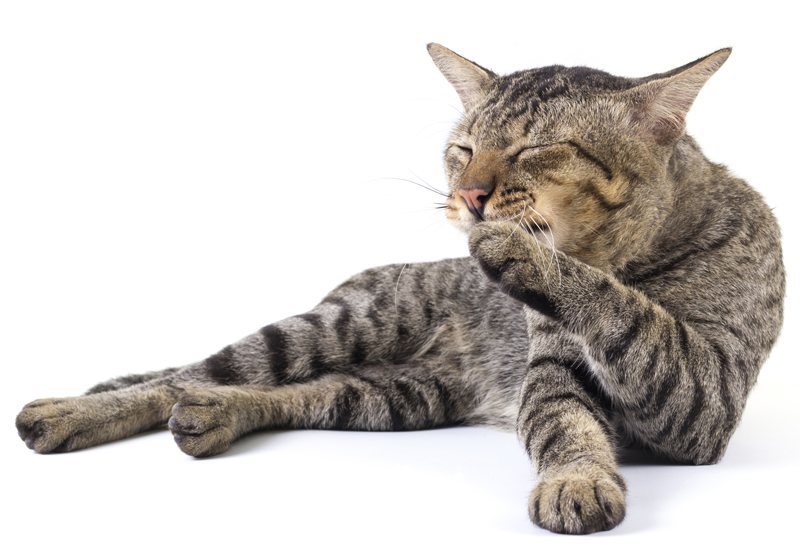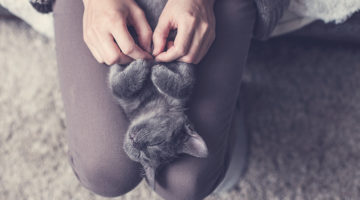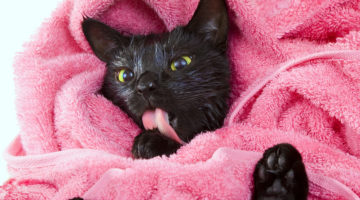Cats spend a lot of time cleaning themselves, but if they start showing bald patches, it could signal a behavioral problem called psychogenic alopecia.
Watch your cat next time she’s grooming. She closes her eyes as she slowly licks her legs, sides and tail, and uses her paw to wash her face. It looks so relaxed and dignified, even when she does her famous “playing the bass fiddle” pose.
Cats spend almost half their time grooming, according to the Cornell Feline Health Center. We’re so used to seeing it that we may not realize some cats may actually start over-grooming themselves.
Over-grooming isn’t just about a cat licking herself too much. It’s actually the onset of a behavioral problem clinically called psychogenic alopecia. Because most of us don’t think anything of it when we see our cats grooming, the problem isn’t easy to detect until obvious bald patches appear on the cat’s coat.
Possible causes
Cats are creatures of habit. They like routine and find change stressful. Over-grooming most often stems from stress and can be triggered by a variety of situations, including the following:
- A new baby or animal in the house
- A companion cat dying
- Person working long hours
- Divorce
- Neighborhood cats
- Death of a family member
- Moving to a new house
- Child leaving home
- Rearranging the furniture
- Loud noises
Bald patches are first clue
Keeping an eye on the condition of your cat’s fur isn’t too hard to do. If you think your cat is spending an abnormal amount of time grooming, check the areas where balding generally begins or is more visible – the inner thighs or forelegs, tail or abdomen. If you see any balding or short hair stubble, think about what might have changed in your cat’s environment to warrant the over-grooming. It’s important to do something about psychogenic alopecia from the outset because if it continues, it can lead to lesions in the skin and may even trigger the cat to bite and chew herself. It’s the equivalent of biting your nails when you are stressed; pretty soon you have bitten them so low they actually hurt.
According to the book Starting From Scratch: How to Correct Behavior Problems in your Adult Cat, by Pam Johnson-Bennett, it is up to you to try and find out what the cause is, and to help create an environment that is less stressful for the cat. Some problems, such as a death in the family, can’t be helped, but there are ways to help your cat feel calmer about any change.
De-stressing tactics
- Play and attention can help counteract whatever your cat is stressed about. Some extra TLC and one-on-one interaction during a stressful time will distract her and help her feel more secure again.
- If you have to be away at work during the day, you can keep your cat entertained with a DVD created especially for felines (featuring birds, mice, fish, etc.), or by situating a bird feeder outside a window. Try also leaving some toys around so she can play by herself when you’re out. Introducing a new catnip toy every now and then will help engage her.
- If your cat has lost an animal companion, adopting another might be something to consider. Don’t do it right away though; introducing a new animal right on top of the loss may only generate more stress and exacerbate the over-grooming.
- Flower essence such as Bach Rescue Remedy can be very effective. Rub a little on your cat’s ears or paw pads, or just add a few drops to her drinking water.
- A pheromone spray or diffuser is the equivalent of lighting incense to calm the nerves.
Once your cat calms down and de-stresses, she should return to her normal aristocratic grooming habits!
Medically speaking
If you can think of no changes in your cat’s environment that might have triggered her over-grooming, seek veterinary attention. There are several potential medical causes. Once these are treated, the overgrooming should stop.
- Hyperthyroidism (overactive thyroid gland)
- Food allergies
- Fungal infection
- Skin parasites
- Feline ringworm







No Comment